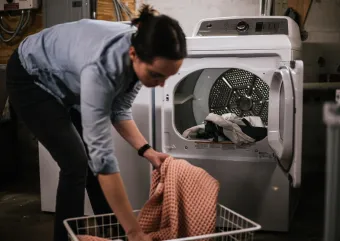When you’re ready to make the switch to electric appliances, you’ll need to decide where to begin. We often hear that residents upgrade one or two pieces of equipment at a time as opportunities present themselves. If you’re ready to electrify your living spaces, replacing your clothes dryer is one way to reduce gas in your home. Electric clothes dryers are more efficient and safer for indoor air quality, making them an excellent step forward.
Clothes Drying
Switching to an electric clothes dryer removes another gas-burning appliance from your home, and you have options for what you can install to replace your existing dryer.
Summary
With multiple electric dryer options, it can be hard to know what will work best for your needs. We’ve put together this comparison chart to help you make a decision.
| Heat Pump Dryer | Electric Resistance Dryer | Compared To | |
|---|---|---|---|
| Lifespan | 20 years | 10–15 years | 10–15 years |
| Drying Time | Slower | Faster | Faster |
| Venting to Outside | None | Required | Required |
| Treatment of Clothes | Gentler | Less gentle | Less gentle |
| Cost Per Load | Lowest | Highest | Middle |
System Options
Switching to an electric clothes dryer is a cost-effective way to save energy at home while reducing indoor air pollution.
Heat Pump Dryer
Heat pump dryers, often called ventless dryers, use warm air to transfer moisture out of clothes and into a nearby condensate pan or drainpipe. This process is more energy efficient and gentler on clothes, but it can have a longer dry time. One benefit of a heat pump dryer is that it does not need to be vented to the outside, which gives you more flexibility in where you place it.
Electric Resistance Dryer
Electric resistance dryers use heat from electric coils, not combustion gas, to dry clothes. They are more widely available and affordable than other electric dryer options, and they dry clothes faster. However, they are less energy efficient than heat pump dryers, using about twice as much electricity. They also require traditional venting.
Installation and Contractors
Electric clothes dryers need 240-volt plugs, but your home likely already has one where your current clothes dryer is. If not, an electrician can install a new plug for you. Once you’re ready to purchase your new appliance, we’ve found that most major box stores offer appliance delivery and installation services for little to no cost. For details on what delivery and installation services are available, we recommend speaking directly to an employee at your preferred store.
Financial Incentives
Financial incentives for electric clothes dryers vary based on your location. For full financial incentive details, please visit our incentives page.
Electrify Your Clothes Drying with Electrify Everything Minnesota
Ultimately, the decision of what type of electric clothes dryer to purchase and install will depend on factors like your home and its electrical system, your lifestyle, and your budget. This buyer’s guide is meant to be a first step in your decision-making process. If you still have more questions about what might work best for your home, residents of our partner communities can contact an electrification advisor for free, one-on-one advice. Our advisors will learn more about your home and help you consider the pros and cons of your options. Contact them via email or by scheduling a call today. Make a confident decision on your next electrification upgrade.
